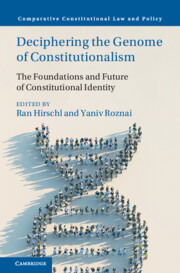Book contents
- Deciphering the Genome of Constitutionalism
- Comparative Constitutional Law and Policy
- Deciphering the Genome of Constitutionalism
- Copyright page
- Contents
- Figures
- Contributors
- Preface
- Acknowledgments
- Introduction
- Part I Foundations, Theory, and Concepts
- Part II Comparative Perspectives
- Part III American Constitutionalism and Constitutional Identity
- Part IV Emerging Trends
- 19 Constitution Making and Disharmonic Identity
- 20 Constitutional Identity and Unamendability
- 21 Illiberal Constitutionalism and the Abuse of Constitutional Identity
- 22 Deconstructing Constitutional Identity in Light of the Turn to Populism
- 23 Unconstitutional Constitutional Identities in The European Union
- 24 What Counts as Constitutional Identity?
- 25 Contrariness and Contradiction in Constitutional Law
- 26 Conclusion
- Index
- References
20 - Constitutional Identity and Unamendability
from Part IV - Emerging Trends
Published online by Cambridge University Press: 14 March 2024
- Deciphering the Genome of Constitutionalism
- Comparative Constitutional Law and Policy
- Deciphering the Genome of Constitutionalism
- Copyright page
- Contents
- Figures
- Contributors
- Preface
- Acknowledgments
- Introduction
- Part I Foundations, Theory, and Concepts
- Part II Comparative Perspectives
- Part III American Constitutionalism and Constitutional Identity
- Part IV Emerging Trends
- 19 Constitution Making and Disharmonic Identity
- 20 Constitutional Identity and Unamendability
- 21 Illiberal Constitutionalism and the Abuse of Constitutional Identity
- 22 Deconstructing Constitutional Identity in Light of the Turn to Populism
- 23 Unconstitutional Constitutional Identities in The European Union
- 24 What Counts as Constitutional Identity?
- 25 Contrariness and Contradiction in Constitutional Law
- 26 Conclusion
- Index
- References
Summary
Gary Jacobsohn’s work on constitutional identity was an early exemplar of constitutional theory, testing and refining broad theoretical claims against a deep analysis of constitutional developments in diverse constitutional systems. One aspect of Jacobsohn’s rich and multi-textured theory is the claim that constitutional identity constrains amendment powers. This chapter explores that claim through the lens of the two seminal Irish cases with which Jacobsohn engages. These cases, while rejecting unamendability, illustrate Jacobsohn’s central distinction between generic constitutional identity and particular constitutional identity. The chapter argues that while Jacobsohn is correct to claim that generic constitutional identity – conformity to the moral values of constitutionalism – constrains constitutional amendment, it is problematic to assign moral salience to a country’s distinctive constitutional identity. The chapter interprets Jacobsohn’s particular constitutional identity not as a substantive constraint on amendment but rather as an argumentative frame for debate about the legitimacy of amendments. This argumentative frame, however, lacks a sound normative basis and encourages an excessive focus on the constitutional past, diminishing the potential of constitutional amendment as a site of democratic deliberation.
Keywords
- Type
- Chapter
- Information
- Deciphering the Genome of ConstitutionalismThe Foundations and Future of Constitutional Identity, pp. 259 - 271Publisher: Cambridge University PressPrint publication year: 2024



